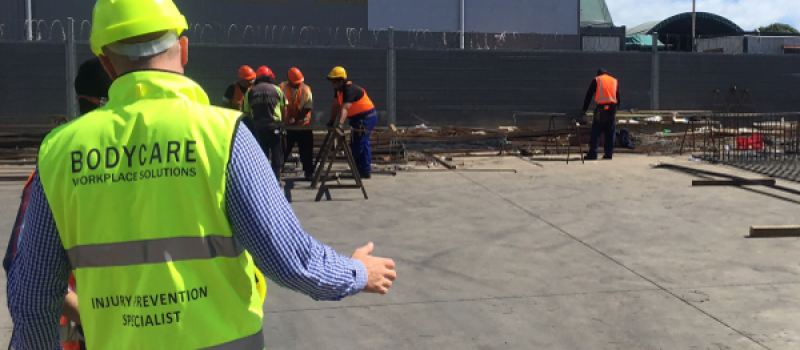Healthy Bodies
ONSITE INJURY PREVENTION SERVICES
Onsite Occupational Physiotherapy – FAQ’s
1. What is the role of an onsite physiotherapist?
An onsite physiotherapist attends your workplace regularly to provide treatment and advice to your employees while they are at work. This stops employees leaving the work site for external treatment and allows for immediate treatment of an injury. An onsite physio has the ability to observe workers performing tasks in their regular work environment which allows them to provide informed treatment and advice about injury prevention, injury management and recovery. An onsite physio facilitates improved communication between the injured worker, the treating physiotherapist and the management or workplace health and safety team by providing regular updates on the progress of the workers recovery.
Bodycare’s physiotherapists provide a detailed explanation of the anatomy of the body area at most risk and emphasise the relevance of the anatomy and biomechanics in that particular body part and the influence it has on causing of an injury in a particular work environment. Furthermore, our specialists discuss the best practices to avoid injury to a body part such as relevant task specific stretches and strengthening exercises and advice.
Bodycare’s onsite physiotherapists are fully trained health professionals who can provide a variety of treatment and advice to your employees, including:
- Deep tissue massage
- Spinal and peripheral joint mobilisation and manipulation
- Dry needling
- Muscle Energy Technique
- Myofascial releases
- Task specific strengthening & stretching programs for postsurgical rehabilitation or return to work training
- Core stability and balance training
- Functional task training/retraining
[i] 84 days refers to the Average Number of Days between an Injury and a Report, WCD 2014

2. What is the difference between physiotherapy treatment and injury prevention?
Injury prevention is more than just physiotherapy. Whilst physiotherapy makes up a component of injury prevention, its only one piece of the puzzle. Traditionally, the average employee does not report an injury for as many as 84 days[i]. This length of time can lead to injuries deteriorating and lasting for extensive periods, resulting in expensive claims.
Bodycare’s onsite injury prevention model is successful because it goes beyond treatment provision. We encourage employees to move from a reactive to a proactive mindset by encouraging them to present early for treatment of niggles, aches and pains before they become injuries. Having our injury prevention specialists proactively roam, observe and engage with employees and discuss their manual handling techniques, work station set up and the frequency of breaks and stretches, ensures that low grade niggles and aches are managed before they develop into a costly burden.
This approach empowers managers, supervisors and employees to take effective actions to attain meaningful outcomes.
Bodycare’s onsite injury prevention specialists:
- Engage with employees while they work, not just in the treatment room
- Teach employees how to avoid injury through correct manual handling technique assistance
- Are able to provide treatment and injury prevention advice for work and non-work related injuries
- Can assist with safe return to work for employees on WorkCover claims
- Can complete risk assessments and adjust workstations
Some of the tools that Bodycare use to ensure we are all preventing injuries, mitigating risks and improving workplace safety are:
- Manual handling advice and reinforcement
- Injury Prevention Insights
- Proactive Roaming & Observation
- Ergonomic Assessments and Advice
- Functional Movement Screen
- Workplace and Risk Assessments
- Functional fitness programs
3. What are the benefits of having a Bodycare injury prevention service onsite?
- Employees are provided with immediate assessment, diagnosis and treatment of an injury by a trained professional
- Injuries are treated in a timely and effective manner within your workplace, reducing loss off productivity and costs associated with employees leaving the workplace to be treated by an offsite health provider
- The availability of an onsite physiotherapy service facilitates early intervention by allowing employees to be treated for niggles, aches or pains, before they develop in severity
- Bodycare physiotherapists proactively roam onsite and provide on the job education and training to you employees such as correct manual handling techniques or process improvements in order to prevent injuries from occurring
- If an employee is injured, your onsite physiotherapist can facilitate and expedite the return to work by providing modifications to duties, providing rehabilitation treatment and opening the lines of communication between medical professionals, managers and the injured worker to create a supportive and practical pathway for returning to work earlier
- Early intervention and accelerated return to work practices reduce the overall cost of your business’ workers’ compensation claims and insurance premiums.
4. Why should I choose Bodycare’s services over an alternative onsite physiotherapy service?
Our online booking system
Bodycare has developed a secure online booking platform making it easy for employees to be booked in for appointments by their managers. This online diary can be accessed by selected management only. The booking software can send out notifications or email reminders to both the employee and their manager regarding post treatment instructions or reminders.
Our exclusive injury prediction software
Bodycare has developed an exclusive, online software program called the Healthy Workplace Dashboard that compiles meaningful injury-related data. Not only does the software serve as a live electronic platform for gathering medical information from patients/employees, it actually enables employers to obtain a clearer understanding of the nature of workplace injuries that are occurring, and to measure the effectiveness of the ways in which they are prevented and managed.
Our collaborative approach
We know that to make workplaces safer and less prone to injury an integrated, focused approach around a common goal is necessary. This collaboration involves not only Bodycare and our clients, but all those involved in managing workplace injuries. This includes insurers, brokers, rehab consultants, case managers as well as other medical or allied health professionals.
Our effective communication and reporting
As part of Bodycare’s commitment to delivering a valuable injury prevention service, we will ensure that your team is on the same page as ours across multiple different management levels. Our online software platform also serves a valuable communication tool in that it sends regular notifications to managers across all levels regarding particular aspects of the onsite physiotherapy service including:
- Injury alerts
- Injury updates
- Red flag updates
- Offsite treatment updates and notifications
- Quarterly analysis and presentation utilising software to create a proactive injury prevention program
5. What happens when an injury occurs outside of the onsite physiotherapy times?
Bodycare’s physiotherapists create a proactive environment with the aim that many acute injuries will be avoided altogether however, we understand that injuries may still occur. In this case, Bodycare has established a national network of clinics that employees can be booked into to ensure they receive the best possible treatment until the next session time.
6. What happens when an employee’s injury required further investigation or referral to a specialist?
If the physiotherapist is treating an employee with an injury that requires referral to a specialist or who has reached their treatment limit, the onsite physiotherapist will communicate with the employee’s manager prior to making any referral.
If the employee is on restricted duties, the physiotherapist will communicate this to the GP so they are aware that these duties are available.
7. What is the difference between Physiotherapy and Occupational Therapy?
While both Occupational Therapists and Physiotherapists both do rehabilitative work, the two roles are quite different from one another.
A Physiotherapist focuses on treating an individuals injury (whether that is a torn ligament, fracture or another injury that has impaired their mobility), and works to improve the individuals ability to perform a movement. An Occupational Therapist on the other hand will help a person who has suffered an accident or illness live as independently as possible by improving their ability to perform everyday tasks.
8. When should you see a physiotherapist?
If you have a niggle, ache or pain it is recommended that you see a physiotherapist immediately. Infact the treatment of niggles, aches and pains within 1-7 days is known to significantly reduce the severity of an injury and reduce the likelihood of the issue escalating into a larger problem.
This is where the benefit of having a Physiotherapist onsite really comes in handy – it ensures that all injuries can be accessed and treated immediately.
